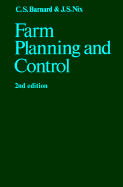Book contents
- Frontmatter
- Contents
- Notice to readers
- Preface to the first edition
- Preface to the second edition
- Selected metric conversion factors
- Part I The organisation of resources
- 1 The planning environment and the managerial function
- 2 Basic principles and concepts of planning
- 3 The organisation of capital – general
- 4 The organisation of capital – machinery, buildings and land
- 5 The organisation of labour
- Part II The organisation of enterprises
- Part III The combination of enterprises
- Part IV The control of resources and enterprises
- Selected further reading
- Index
3 - The organisation of capital – general
Published online by Cambridge University Press: 01 June 2011
- Frontmatter
- Contents
- Notice to readers
- Preface to the first edition
- Preface to the second edition
- Selected metric conversion factors
- Part I The organisation of resources
- 1 The planning environment and the managerial function
- 2 Basic principles and concepts of planning
- 3 The organisation of capital – general
- 4 The organisation of capital – machinery, buildings and land
- 5 The organisation of labour
- Part II The organisation of enterprises
- Part III The combination of enterprises
- Part IV The control of resources and enterprises
- Selected further reading
- Index
Summary
Types of farming capital
'Capital' in farming refers to the total finance required in order to operate a farm business. In the case of an owner-occupier this includes the purchase of land with its associated facilities: roads, drains, ditches, hedges and at least most of the buildings. This may be variously referred to as landlord's capital, fixed capital, or long-term capital, and is discussed further in Chapter 4.
The present chapter relates mainly to the remaining capital – that needed to equip, stock and run the farm. This is normally called 'tenant's' capital, even though fewer than half of British farms are now rented. Tenant's capital may be divided into medium-term and short-term capital. The former consists of plant and machinery and breeding (or 'production') livestock – such as dairy cows, beef cows, ewes and sows. Some include breeding livestock in fixed capital on the grounds that the farm would lose a major source of revenue if such stock were sold; however, several points can be made against this argument and such livestock are better considered as being medium-term capital. Pig and poultry houses expected to last no longer than ten years are also often supplied by the tenant on rented farms and are better regarded as medium-term capital than long-term capital. Both medium and long-term capital supply a 'flow' of services, as it were, over time; most medium-term capital items provide this flow for a period of up to ten years, whereas many long-term capital assets do so for considerably longer.
- Type
- Chapter
- Information
- Farm Planning and Control , pp. 50 - 79Publisher: Cambridge University PressPrint publication year: 1980



